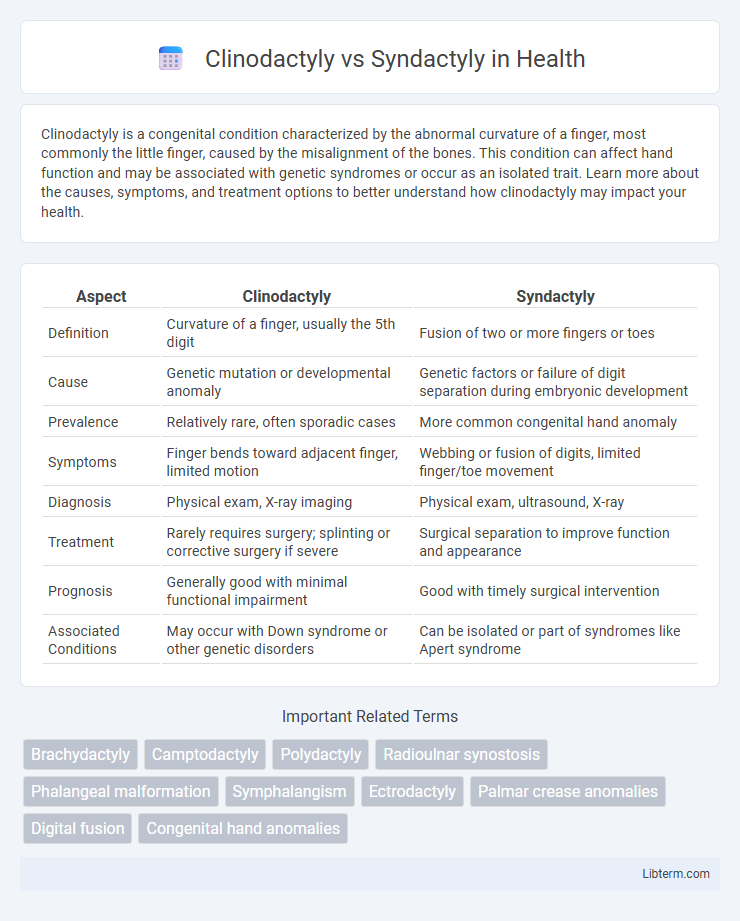Clinodactyly is a congenital condition characterized by the abnormal curvature of a finger, most commonly the little finger, caused by the misalignment of the bones. This condition can affect hand function and may be associated with genetic syndromes or occur as an isolated trait. Learn more about the causes, symptoms, and treatment options to better understand how clinodactyly may impact your health.
Table of Comparison
| Aspect | Clinodactyly | Syndactyly |
|---|---|---|
| Definition | Curvature of a finger, usually the 5th digit | Fusion of two or more fingers or toes |
| Cause | Genetic mutation or developmental anomaly | Genetic factors or failure of digit separation during embryonic development |
| Prevalence | Relatively rare, often sporadic cases | More common congenital hand anomaly |
| Symptoms | Finger bends toward adjacent finger, limited motion | Webbing or fusion of digits, limited finger/toe movement |
| Diagnosis | Physical exam, X-ray imaging | Physical exam, ultrasound, X-ray |
| Treatment | Rarely requires surgery; splinting or corrective surgery if severe | Surgical separation to improve function and appearance |
| Prognosis | Generally good with minimal functional impairment | Good with timely surgical intervention |
| Associated Conditions | May occur with Down syndrome or other genetic disorders | Can be isolated or part of syndromes like Apert syndrome |
Introduction to Clinodactyly and Syndactyly
Clinodactyly is a congenital deformity characterized by the abnormal curvature of a finger, most commonly the fifth finger, due to an angulated growth plate or bone malformation. Syndactyly involves the fusion of two or more fingers or toes, either partially or completely, resulting from the failure of digit separation during embryonic development. Both conditions represent common congenital hand anomalies with distinct anatomical features and surgical implications.
Definition of Clinodactyly
Clinodactyly is a congenital condition characterized by the abnormal curvature of a finger, most commonly the fifth finger, due to the bending of the middle phalanx. It contrasts with syndactyly, which involves the fusion or webbing of two or more fingers. Clinodactyly results from asymmetrical growth of the phalanges or abnormal positioning of the joint, leading to a bent finger without webbing.
Definition of Syndactyly
Syndactyly is a congenital anomaly characterized by the fusion of two or more fingers or toes, resulting in webbed or fused digits. This condition involves the failure of the embryonic tissue separating the digits to undergo normal apoptosis, leading to soft tissue or bone fusion. Syndactyly can vary in severity, ranging from simple soft tissue connection to complex bony fusion, often affecting hand functionality.
Causes and Risk Factors
Clinodactyly is primarily caused by abnormal growth or malformation of the bones in the fingers, often linked to genetic factors such as mutations in the genes controlling bone development, while syndactyly results from incomplete separation of the fingers during embryonic development due to disruptions in programmed cell death. Risk factors for clinodactyly include inherited conditions like Down syndrome and Turner syndrome, whereas syndactyly is frequently associated with genetic syndromes such as Apert syndrome and Poland syndrome. Both conditions may also arise sporadically without a clear familial history, influenced by environmental factors or prenatal exposure to teratogens.
Genetic Components and Inheritance
Clinodactyly is typically caused by genetic mutations affecting the growth of the middle phalanx, often inherited in an autosomal dominant pattern with variable expressivity. Syndactyly results from genetic alterations in developmental genes like HOXD13, leading to fused digits, and commonly follows autosomal dominant inheritance with incomplete penetrance. Both conditions involve key genetic components that disrupt normal digit formation, highlighting their hereditary nature and importance in genetic counseling.
Clinical Presentation and Symptoms
Clinodactyly is characterized by a curvature of the fingers, most commonly affecting the fifth finger, resulting in a bent appearance, often noticeable at birth or early childhood. Syndactyly presents as the fusion of two or more fingers or toes, varying from simple skin webbing to complex bony fusion, leading to impaired digit function depending on severity. Both conditions may cause functional limitations, but clinodactyly primarily affects finger alignment, while syndactyly impacts digit separation and mobility.
Diagnosis and Differentiation
Clinodactyly is diagnosed through physical examination revealing curvature of a digit, typically the fifth finger, whereas syndactyly involves the fusion of two or more fingers or toes identified by webbing or skin connection. Radiographic imaging is crucial for differentiation: clinodactyly shows angulated phalanges without bone fusion, while syndactyly displays bone or soft tissue fusion between adjacent digits. Genetic testing may assist in distinguishing isolated cases from syndromic associations for both conditions.
Treatment Options and Management
Treatment options for clinodactyly primarily involve corrective osteotomy in severe cases to straighten the curved finger, often combined with physical therapy to improve function. Syndactyly management typically requires surgical separation of fused digits during early childhood to enhance hand mobility and prevent growth deformities, sometimes followed by skin grafting to cover exposed areas. Postoperative care for both conditions includes splinting, occupational therapy, and monitoring to ensure proper healing and optimal hand functionality.
Prognosis and Potential Complications
Clinodactyly typically presents with a curved finger and generally has a good prognosis, often requiring no treatment unless it impairs function or causes discomfort. Syndactyly involves webbing or fusion of two or more fingers or toes, with prognosis dependent on the severity and extent of fusion, often requiring surgical intervention to improve function and appearance. Potential complications for clinodactyly are usually minimal, but syndactyly can lead to functional impairment, nerve damage, or scarring post-surgery if not properly managed.
Key Differences Between Clinodactyly and Syndactyly
Clinodactyly involves the curvature of a finger, usually the fifth digit, caused by an abnormal bone shape, while syndactyly is characterized by the fusion or webbing of two or more fingers or toes. Clinodactyly results primarily from metacarpal or phalangeal bone malformations, whereas syndactyly arises from soft tissue abnormalities such as skin or connective tissue fusion. Treatment approaches differ as clinodactyly often requires corrective osteotomy, while syndactyly typically involves surgical separation to restore digit function and appearance.
Clinodactyly Infographic

 libterm.com
libterm.com